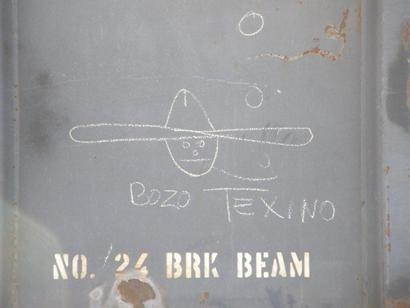|
|
The
question has been asked many times and in many forms: “Who is Bozo
Texino?”
We have to assume that people have been asking that question since
the late 1920s, when Bozo Texino burst upon the art scene, provided
we’re willing to make room for railroad
boxcar graffiti in our art scene.
|
 |
And why shouldn’t
we do just that? Media critic Marshall McLuhan once said, “Art is
anything you can get away with.” This Bozo Texino character got away
with his art for the better part of at least two decades and left
countless imitators in his wake. Patrons of urban art scenes may wrinkle
their nose at Bozo but his art has enjoyed an audience most artists
can only dream about.
Before there was the famous smiley face of the 1970s, which urged
all of us to “Have a Nice Day,” and even before Kilroy, the hero of
World War II
graffiti made famous by a distinctive drawing and the words “Kilroy
Was Here,” there was Bozo Texino.
Bozo Texino was the signature assigned to several thousand doodles
drawn on railroad boxcars with a waterproof crayon. The signature
featured a character with a big, wide-brimmed cowboy hat, a pipe,
a scowl, and the words “Bozo Texino.” Bozo Texino’s art was always
on tour, carrying trainloads of art everywhere the rails ran. People
in Maine were as likely to see one of Bozo’s drawings as people in
California or Michigan.
So who was Bozo Texino?
Not
too surprisingly, Bozo Texino was not the artist’s real name. The
drawings and the distinctive signature were the work of one J.H.
McKinley of San Antonio,
a fireman for the Missouri-Pacific Railroad. (It’s said that McKinley
did not ply his trade on Missouri-Pacific rail cars because company
policy forbade it, but the company apparently didn’t mind McKinley
doodling on competitors’ boxcars.)
Bozo’s identity wasn’t exactly a secret. McKinley even wrote a humor
column called “Bozo Texino Sez” for Missouri-Pacific magazine. Gene
Fowler, in his book “Mavericks,” quotes a 1939 interview with the
San Antonio Light where McKinley told a reporter that a nephew nicknamed
him Bo when the two worked together in Laredo.
“I just took the ‘Bo’ and added a ‘zo,’ so it would rhyme with Laredo,”
McKinley said. “I used to sign it ‘Bozo Laredo’ until I came to San
Antonio, then kind of shortened Texas and Mexico to get ‘Texino.’”
|
The
most notable attention paid to our very own Bozo comes from filmmaker
Bill Daniel, who spent 16 years hopping freights and riding the rails
to make the documentary film “Who Is Bozo Texino?” Daniel answers
the title’s question but not to everybody’s satisfaction because to
some people the mystery of Bozo Texino might be more important than
his true identity.
For Daniel, the mystery began when he saw his first Bozo Texino image
in a Dallas rail yard. Then
he saw another one, and another. He saw Bozo Texino in Fort
Worth and Houston.
Bozos were everywhere. |
|
“I figured I
discovered some kind of secret hobo art movement,” he told the Fort
Worth Star Telegram in 2006, just after the movie was released. “It
was stuff that looked to be a full-on underground art scene, a boxcar
graffiti cult with hundreds of characters…At first I thought it
was hobo art, but it turned out they were done by both railroad workers
and hobos.”
A bonus to delving into the murky sub-culture of hobos and railroad
graffiti is the great nicknames. Some examples: Frisco Jack, Big
Red, Pal Tree Herbie, Mojave Don, Coal Train, Road Hog, Itchyfoot
Stetson and Water Bed Lou.
Others have signed their boxcar
graffiti “Bozo Texino” in subsequent decades. Bozo has even spawned
what could be classified as a sub-genre of artists who go by the names
Bozo Mexino, Bozo Bambino and Bozo Texina.
If nothing else, the names could inspire any number of musicians who
might otherwise believe that all the good stage names have been taken.
A concert by a band or performer named Bozo Texino with opening act
Itchyfoot Stetson would probably draw a certain number of fans based
on the names alone.
© Clay Coppedge
"Letters from Central Texas"
May 2,
2009 Column |
|
|
